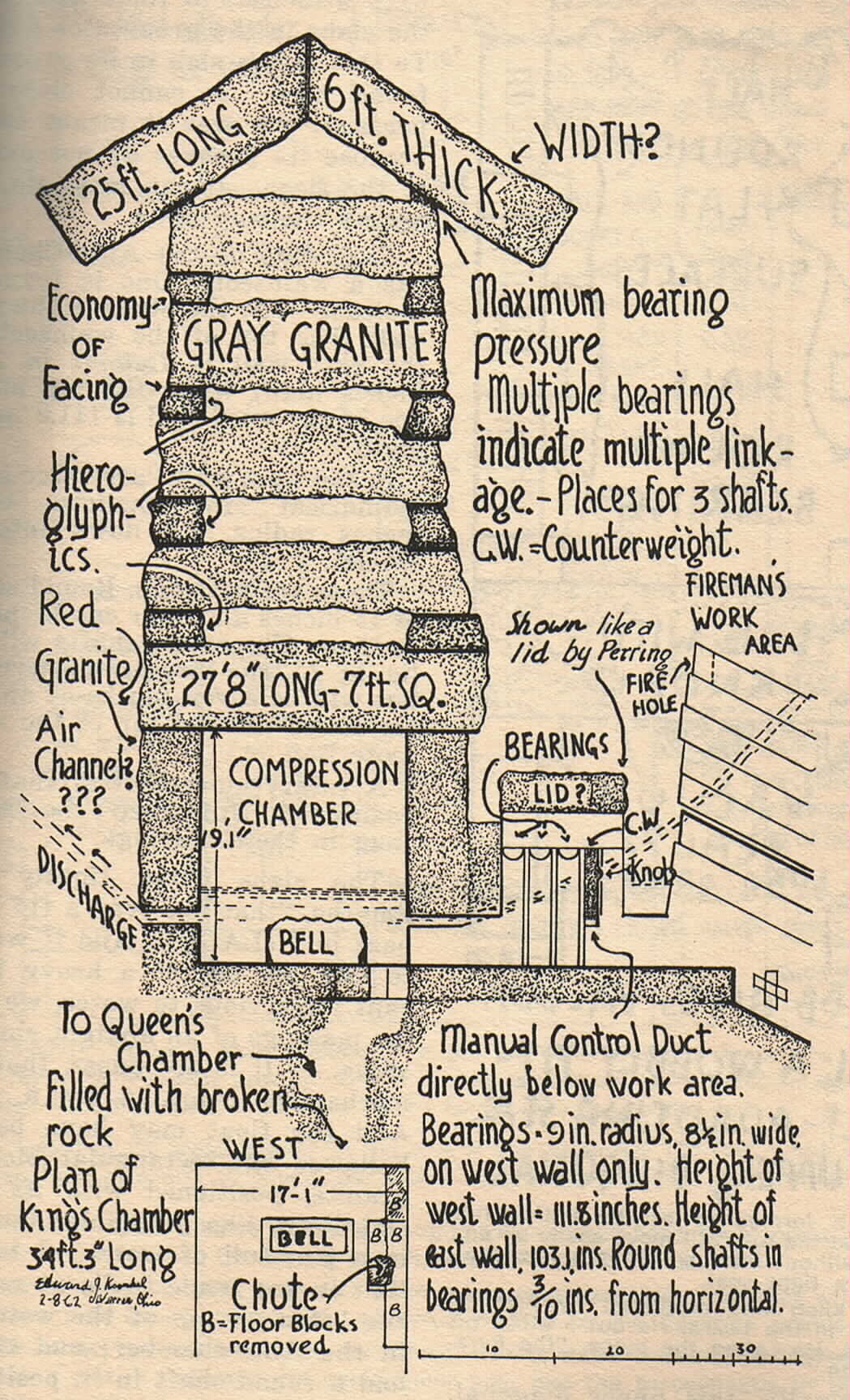

How the Great Pyramid
At Giza was built, and Why!
 "King's Chamber"
"King's Chamber" 

The King's and Queens Chamber work in conjunction with one another.
When the vacuum seal is opened at the top of the Grand Gallery, water flows
down the Grand Gallery. The check valve below the Grand Gallery is
closed, and the valve in the antechamber is opened. The column of
water flows into the queen's chamber compressing the air in the upper
area of the Queen's Chamber. When the water level in the Grand Gallery
reaches the bottom of its travel the valve in the antechamber shuts.
This creates a condition where the compressed air in the upper part of
the King's Chamber pushes water up to the Kings Chamber.
The vents in the King's Chamber are located about 4 1/2 feet from the
floor. The ceiling is about 19 feet high. If these vents are
air vents then they are poorly designed. If they were air vents then
they would work better if they were nearer to the ceiling. Some people
maintain they are air vents because air is vented through them. It
is the contention of the Pharaoh's Pump Foundation that these passages
are for the discharge of water to the outside of the pump. The location
of the vents and being airtight, (actually water tight!) are consistent
with this "room" being an air compression chamber above the vents and water
below.
 Below are a few excerpts from the book Pharaoh's Pump. Although they
are taken out of context they indicate what the book talks about, and the
detail of the explanation of the Great Pyramid as a machine. The output
of the pump is constant, because of the stored energy of the compressed
air. It is not intermittent as shown in the animated image.
Below are a few excerpts from the book Pharaoh's Pump. Although they
are taken out of context they indicate what the book talks about, and the
detail of the explanation of the Great Pyramid as a machine. The output
of the pump is constant, because of the stored energy of the compressed
air. It is not intermittent as shown in the animated image.
Khalaph Al Mamoon, a Mohammedan invader, opened the Great Pyramid
for the first time in the year of 835 A. D. He believed, as did many others,
that the pyramids were repositories of great treasure, and he like many
others since, have found nothing of the sort. Mamoon's men —used
fire and axes to break through the "blocked doorway," or, "the concealed
doorway," that protected the King's Chamber.
As they whacked away at these slabs, the broken rock began to
clutter up their wreckage area, and from time to time were compelled to
remove the pieces. The most convenient place to get rid of this broken
rock, was to throw it down the duct. It was nearby, and the floor
of the King's Chamber could be kept clean.
I believe that if these pieces of rock are removed from this
duct, where they have lain undisturbed for the last 13 centuries, are sorted
and matching pieces cemented together, we will get an accurate restoration
of this shut-off valve. We may see what the slabs looked like, and
determine how they were formed. Also parts of shafts may be found,
together with shreds of rope. — Jig-saw puzzle fans would have a ball.
I have long believed that, there is not a single fragment within,
that is not a part of the original equipment. Every shred and every
piece is a component, of a functional element. Never, never, will I believe
that this so called "debris" was lugged in from the outside, and stored
or hidden, just for the fun of it.
About four feet above the floor of the King's Chamber, two vents are
found leading to the outside, One is in the south wall, and the other in
the north wall. They are 8 inches in cross-sectional area, and come
out 275 feet above the pavement. Colonel Vyse poured water down these
vents and learned that they emptied into the King's Chamber. They
are called, "air vents." I am calling them discharge tubes.
This ancient pump is a monstrous thing. The lower
diagonal holds more than eighty tons, while the upper diagonal has a capacity
of more than 300 tons. All told, it takes more than 600 tons to fill
it. And, nowhere, since the time of the Pharaohs, have engineers
worked or experimented, with such great masses of water in this fashion.
Try to imagine the great crushing weight of a mass of 300 TONS.
Try to imagine the shattering shock exerted on the closing buoyant valve,
(described in book) when it suddenly stops the downward flow and diverts
this great mass into the Queen's Chamber.
Try to imagine the tremendous pressure developed in the Queen's Chamber.
— No wonder the walls have wedge shaped blocks, and the roof formed of
great slabs five and one-half feet thick, and how many hundreds of tons
of stone are piled directly on this roof, no one knows.
Then again, there is the roof of the King's Chamber made of 40 ton
blocks, with hundreds of tons more piled on the walls, and topped with
huge stone struts which bear down on the walls with additional leverage,
to keep the roof from blowing off. - One begins to sense that the builders
left a mighty slim margin for safety.
If you haven't already, clicked on other areas of the diagram to learn
about the functions of the pump.
 Home | FAQ
Links
Please send comments or questions regarding these web pages to
Pharaoh's Pump Foundation
Copyright © 1998 Pharaoh's Pump Foundation.
Home | FAQ
Links
Please send comments or questions regarding these web pages to
Pharaoh's Pump Foundation
Copyright © 1998 Pharaoh's Pump Foundation.



